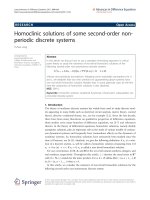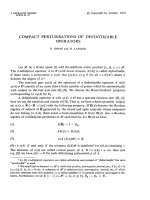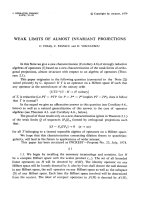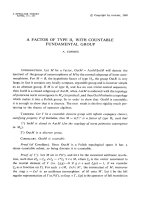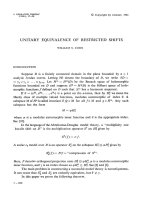Báo cáo toán học: "LATIN SQUARES OF ORDER" potx
Bạn đang xem bản rút gọn của tài liệu. Xem và tải ngay bản đầy đủ của tài liệu tại đây (93.53 KB, 4 trang )
LATIN SQUARES OF ORDER 10
Submitted: August 20, 1995; Accepted: August 25, 1995 (revised)
Brendan D. McKay Eric Rogoyski
Department of Computer Science Cadence Design Systems, Inc.
Australian National University 555 River Oaks Parkway
Canberra, ACT 0200, Australia San Jose, CA 95134, USA
Abstract.
We describe two independent computations of the number of Latin squares of order 10.
We also give counts of Latin rectangles with up to 10 columns, and estimates of the number of
Latin squares of orders up to 15.
Mathematics Reviews Subject Classifications: 05B15, 05-04
1. Introduction.
A k × n Latin rectangle is a k × n matrix with entries from {1, 2, ,n} such that the
entriesineachrowandtheentriesineachcolumnaredistinct. ALatin square of order n is an
n × n Latin rectangle.
A Latin rectangle is said to be normalized if the first row and first column read [1, 2, n]
and [1, 2, ,k], respectively. For example,
123456
231564
354621
is a normalized 3 × 6 Latin rectangle. It is not hard to see that the total number of k × n Latin
rectangles is n!(n − 1)! L(k, n)/(n − k)! , where L(k, n) is the number of normalized k × n Latin
rectangles.
The values of L(n, n)forn =7, 8, 9 were found by Sade [9], Wells [11], and Bammel and
Rothstein [2], respectively. A recurrence for L(3,n) was found by Kerewala [5], and a com-
plicated summation for L(4,n) by Athreya, Pranesachar and Singhi [1]. General formulae for
L(n, n) appear in [3], [8] and [10], but do not appear useful for either exact or asymptotic com-
putation. The asymptotic value of L(k, n)fork = o(n
6/7
) was found by Godsil and McKay [4].
The numbers of distinct Latin squares under various symmetry operations are given to
n = 8 in [6].
The value of L(10, 10) was computed independently by the two authors in 1991 and 1990,
respectively, using similar but not identical methods. In chronological order, we will refer to
these as the “first” and “second” computations throughout this paper. They have much in
common with each other, and also with the method of [2], so we will describe them together.
We wish to thank Neil Sloane for introducing us.
1
2. Description of the computations.
Let R be a k × n Latin rectangle. We can define an associated k-regular bipartite graph
G = G(R)thus: V (G)=C ∪ S,whereC = {c
1
,c
2
, ,c
n
} and S = {s
1
,s
2
, ,s
n
} and
E(G)={c
i
s
j
| column i contains symbol j}. We will call this graph the template of R.
Clearly, many Latin rectangles may have the same template; for example, every Latin square
of order n has the complete bipartite graph K
n,n
as its template.
A one-factor of a graph G is a spanning regular subgraph of degree one. A one-factorization
of G is a partition of E(G) into one-factors. Clearly, the rows of a Latin rectangle R correspond
to the one-factors in a one-factorization of G(R). For any template G, define N(G)tobethe
number of one-factorizations of G, or equivalently the number of normalised Latin squares with
template G. In forming this count, one-factorizations which differ only in the order of the
one-factors are not counted separately. The value of N(G) can be found from the following
recursion:
N(G)=
F
N(G − F ), (1)
where the sum is over one-factors F of G which contain some fixed edge of G. The feasibility
of this computation for n = 10 is due to the fact that N(G) is an invariant of the isomorphism
class of G. Thus, we need only apply (1) to one member of each isomorphism class. The
challenge with efficiency is that the templates on the right need to be identified according to
which isomorphism class they belong.
The two computations differed in the types of isomorphism recognised between two tem-
plates. In the first computation, isomorphisms fixing the sets C and S were used, while in
the second the exchange of C and S was also permitted. In order to apply recursion (1), it is
necessary to be able to identify G − F from amongst the templates for which the value of N()
is already known. In the first computation, this was achieved by defining a canonical labelling
for templates. Templates were stored in canonical form, and templates G − F were identified
by converting them to canonical form. In the second computation, a combinatorial invariant
was devised such that no two templates had the same invariant. The invariant had two com-
ponents. The first component was a quickly-computed number depending on the distribution
of the cycles of length 4 in G − F. This proved sufficient to identify the great majority of
templates uniquely. For those not uniquely identified, there was a second component formed
from a canonical labelling of the template, using the first author’s graph isomorphism program
nauty [7]. The set of nonisomorphic templates was determined in advance using nauty.
The number of distinct templates under the two definitions of equivalence for n =10and
k =1, ,5 were 1, 12, 1165, 121790, 601055 for the first computation, and 1, 12, 725, 62616,
304496 for the second computation.
When N (G) is known for each template G, the number of normalized Latin rectangles can
be determined. In terms of the second computation, we have
L(k, n)=2nk!(n − k)!
G
N(G)
|Aut(G)|
, (2)
where the sum is over all templates of degree k,andAut(G) is the automorphism group of G.
Thereasonfor(2)isthat2n! k!(n − k)!/|Aut(G)| is the number of labellings of G in which the
2
nkL(k,n) nk L(k, n) nk L(k,n)
11 1 71 1 91 1
21 1 23092 16687
21 3 35792 3 103443808
31 1 4 1293216 4 20 7624560256
21 5 11270400 5 11268 1643083776
31 6 16942080 6 12 95260 5404381184
41 1 7 16942080 7 224 38296 7916691456
2381 1 8 377 59757 0964258816
34 221199 377 59757 0964258816
44 3 1673792 10 1 1
51 1 4 4209 09504 2 1 48329
211 5 27206658048 3 8154999232
346 6 33 5390189568 4 14717 4521059584
456 7 53 5281401856 5 746 98838 3076286464
556 8 53 5281401856 6 8 70735 40559 1003709440
61 1 7 177144296 98305 4185922560
253 8 4292039421 59185 4273003520
3 1064 9 7580721483 16013 2811489280
4 6552 10 7580721483 16013 2811489280
5 9408
6 9408
Tab le 1 . Numbers of normalized Latin rectangles.
neighbours of c
1
are {s
1
, ,s
k
},and(n − 1)! is removed to allow for normalization of the first
row. In the case of k = n, equation (2) simplifies to L(n, n)=N(K
n,n
)/(n − 1)! .
Each method requires a few days on a fast workstation. The results are listed in Table 1.
To obtain the total number of Latin rectangles, not necessarily normalized, multiply L(k, n)by
n!(n − 1)!/(n − k)! .
3. Estimates.
For n =11andk =1, ,5, the numbers of distinct templates under the weaker of our
two definitions of isomorphism are 1, 14, 7454, 5582612, 156473848. Allowing interchange of
C and S gains almost a factor of two, but still the numbers are too large for L(11, 11) to be
computable by our method in a reasonable time. However, we can find approximate values for
higher order using a probabilistic method.
Suppose we form a “random” normalized Latin square with rows R
1
, ,R
n
by this process:
R
1
is the usual first row for a normalized square. For i =2, ,n, R
i
is chosen uniformly at
3
random from amongst those extensions of [R
1
, ,R
i−1
]whichhavei in the first position. For
i =1, ,n− 1, let e
i
be the total number of such extensions of [R
1
, ,R
i−1
]. Then it is easy
to show that e
1
e
2
···e
n−1
is an unbiased estimator of L(n, n). (This is an example of a method
originally due to Knuth.) For best experimental efficiency, we computed e
i
exactly for i>n−8
and by testing random permutations for smaller i.
In Table 2, we present our estimates and the number of trials used for each n.Itisnot
possible to be precise about the accuracy, but we feel that probably these numbers are correct
to within one value of the least significant digit.
n trials L(n, n)
11 1000000 5.36 × 10
33
12 1100000 1.62 × 10
44
13 400000 2.51 × 10
56
14 200000 2.33 × 10
70
15 20000 1.5 × 10
86
Tab le 2. Estimates of L(n, n) for larger n.
References.
[1] K. B. Athreya, C. R. Pranesachar and N. M. Singhi, On the number of Latin rectangles
and chromatic polynomial of L(K
r,s
), European J. Combinatorics, 1 (1980) 9–17.
[2]S.E.BammelandJ.Rothstein,Thenumberof9× 9 Latin squares, Discrete Math., 11
(1975) 93–95.
[3] I. Gessel, Counting Latin rectangles, Bull.Amer.Math.Soc., 16 (1987) 79–83.
[4] C. D. Godsil and B. D. McKay, Asymptotic enumeration of Latin rectangles, J. Combina-
torial Theory, Ser. B, 48 (1990) 19–44.
[5] S. M. Kerewala, The enumeration of Latin rectangle of depth three by means of difference
equation, Bull. Calcutta Math. Soc., 33 (1941) 119–127.
[6] G. Kolesova, C. W. H. Lam and L. Thiel, On the number of 8 × 8Latinsquares,J.
Combinatorial Theory, Ser. A, 54 (1990) 143–148.
[7] B. D. McKay, nauty users’ guide (version 1.5), Technical Report TR-CS-90-02, Computer
Science Dept., Australian National University, 1990.
[8] J. R. Nechvatal, Asymptotic enumeration of generalised Latin rectangles, Utilitas Math.,
20 (1981) 273–292.
[9] A. Sade, Enumeration des carr´es latins. Application au 7
e
ordre. Conjecture pour les ordres
sup´erieurs, Marseille, 1948, 8pp.
[10] Jia-yu Shao and Wan-di Wei, A formula for the number of Latin squares, Discrete Math.,
110 (1992) 293–296.
[11] M. B. Wells, The number of Latin squares of order eight, J. Combinatorial Theory, 3 (1967)
98–99.
4
